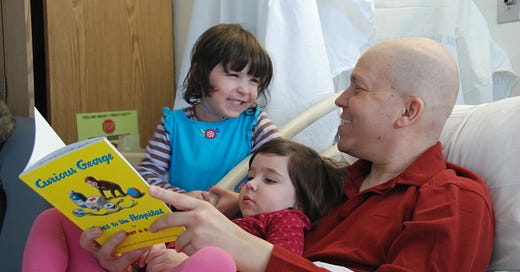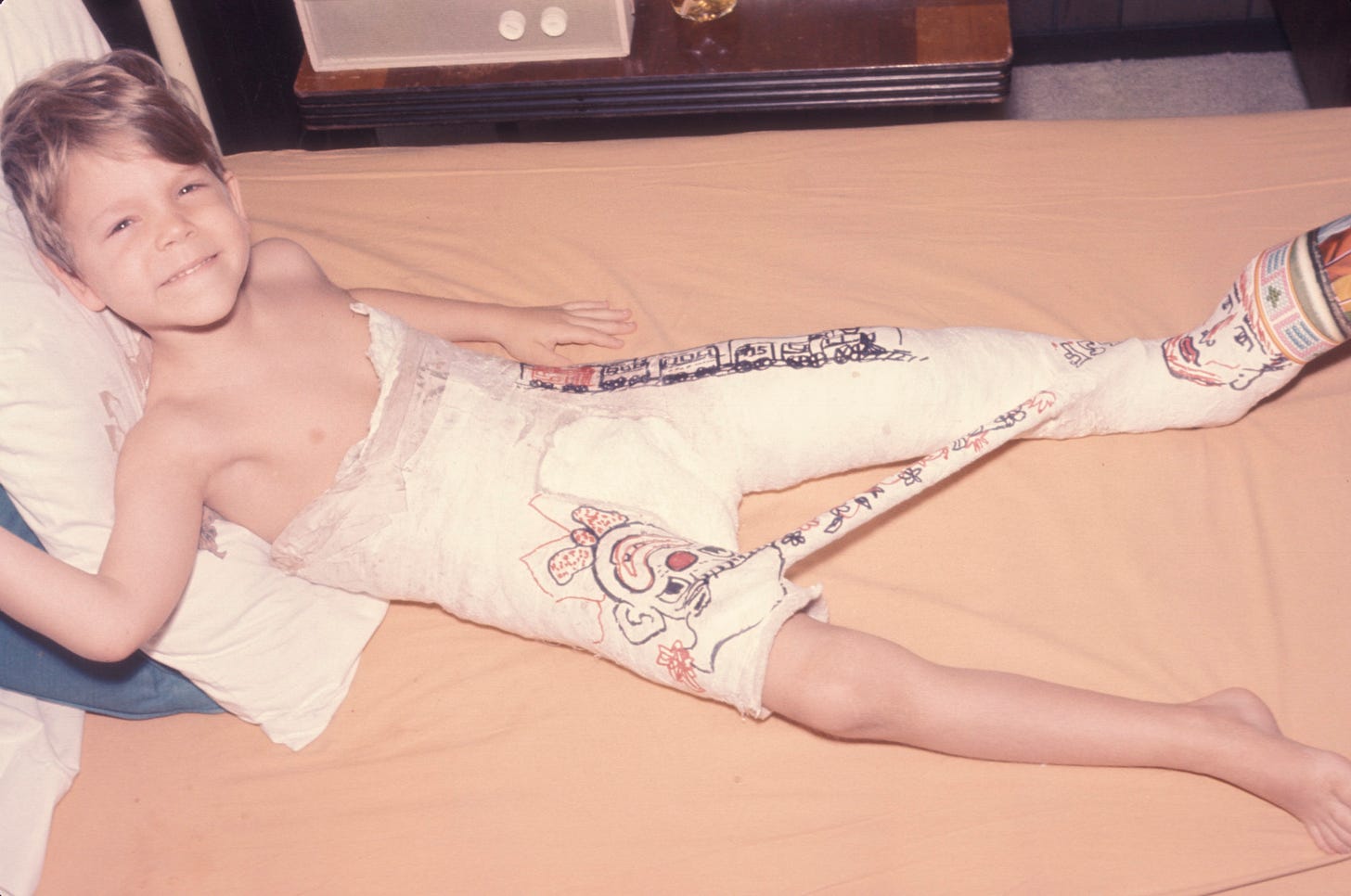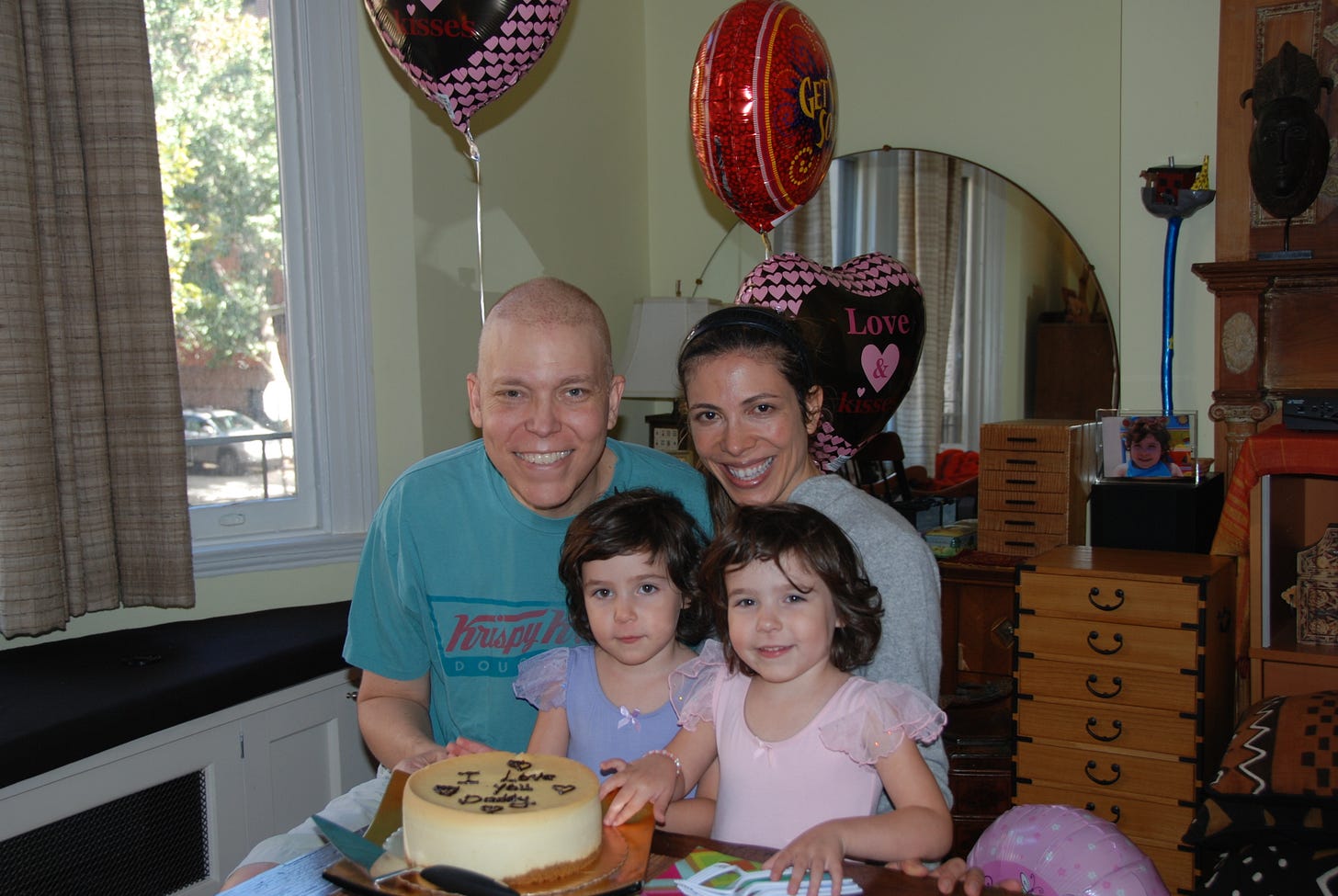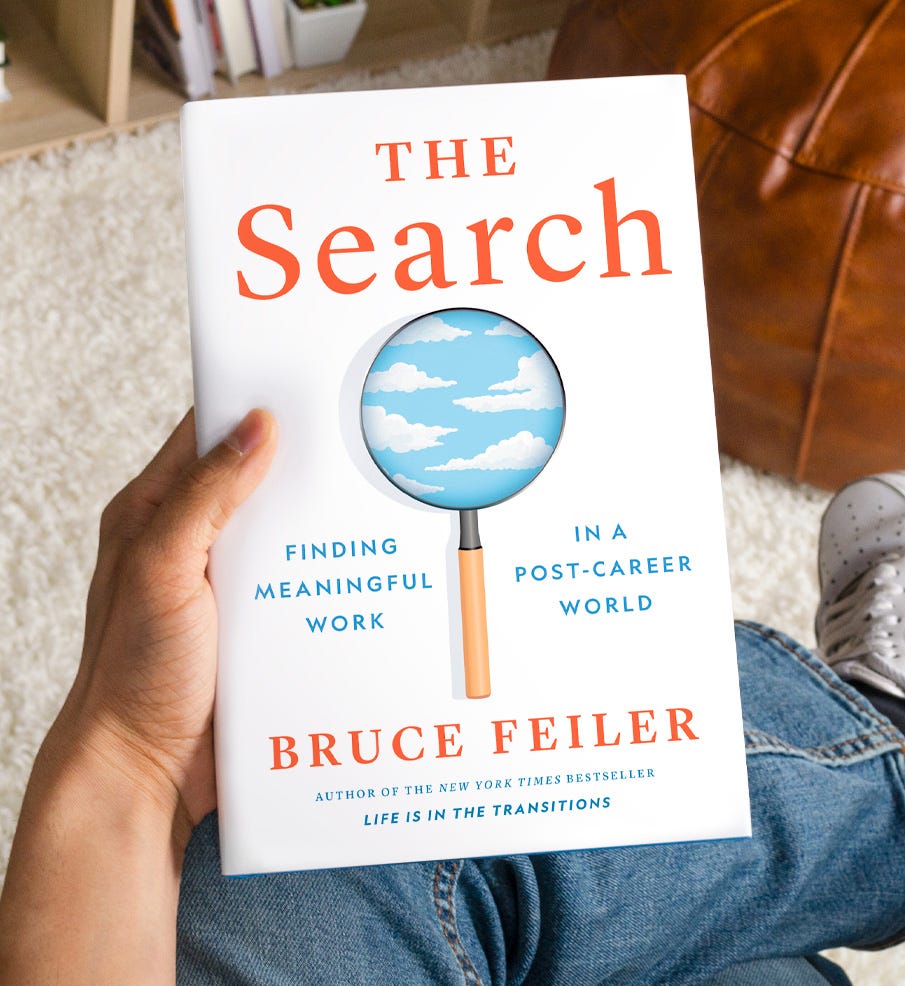The call came on a Tuesday afternoon. I was walking on York Avenue in Manhattan, having just come from an MRI of my left leg. For a number of breathless days, I had been shuttling from one scan to the next as specialists tried to determine what type of mass was growing inside my femur.
Finally, my orthopedist called. “I’ve looked at your scans,” she said. “I insisted a top radiologist in the hospital do the same. And we both agree.” Here she paused to choose the right language. “The growth in your leg is not consistent with a benign tumor.”
I stopped walking. For a second I waited for that double negative to convert itself into a single, more devastating negative.
“I have cancer.”
That phone call set off a chain of singular events that has changed every step, every bite, and every thought of my life ever since. It led me to create The Council of Dads. It led me to devote almost every moment of my work to helping others finding meaning and purpose in what they do.
This month marks the 15th anniversary of that call. That cancer. That lifequake.
Most of what’s happened since — how I turned that awful moment into a life’s work of exploring how others handled similar moments in their life — has been well chronicled. It was the inspiration for at least four books of mine: The Council of Dads, The Secrets of Happy Families, Life Is in the Transitions, The Search.
It is the guiding star of this newsletter.
But what happened in the immediate aftermath of that phone call may be less known to even longtime readers of The Nonlinear Life. So today, on the occasion of this anniversary, I’m taking the unusual step of sharing the letter I wrote to my closest family and friends a few weeks after the scene I described above. I hope it inspires you to take a walk with a turtle. And behold the world in pause.
July 15, 2008
Dear Friends and Family,
The mist lifts slowly off my in-laws’ back lawn on Cape Cod most mornings, revealing a day that is well under way and a layer of dew on the granite boulders. The sky has been gray over Snug Harbor the last few days but at last the clouds have magically parted and the air turned sunny once more.
I apologize for reaching out in this way, but the crush of events in recent days has forced us into a number of uncomfortable situations. I have learned that I have a seven-inch osteogenic sarcoma in my left femur. Put more directly: I have bone cancer. My sarcoma is considered very rare, and very aggressive. It has already eaten through the central shaft of my bone and corroded large portions of the thigh muscle around it. My knee and hip appear to be safe, and early signs that the cancer may have spread to my ribs and lungs have been downplayed. We believe it’s contained to my leg, but the situation continues to be very fluid and could change at any time.
The tumor was discovered by accident after a routine blood test in late May produced an elevated alkaline phosphatase number, a non-specific test indicating possible problems in the liver or bones. My liver was cleared, and a series of tests led us to where we are now. One remarkable aspect of my situation is that I am, for the most part, pain free. This type of tumor usually presents itself through pain, swelling, or fracture. In this regard, we are lucky. As one oncologist said to me recently, “Kudos to your internist for discovering your tumor early.”
Through the generous and swift intervention of friends, Linda and I had a consultation with Dr. John Healey, the head of orthopedic surgery at Memorial Sloan-Kettering Hospital in New York. Dr. Healey has been variously described to us as “the man,” “the one,” or “the guru” in this field. He’s a genial man in his early 50’s with an easy smile, a bow tie, and the unusual-but-arresting manner of speaking about three words every minute. If you hang on his every word – and boy do we! – you hang for a very long time. He also happens to be a fellow graduate of Ezra Stiles College at Yale University and, like me, a teenage juggler and clown.
Dr. Healey spent several hours with us and about halfway through our conversation said of the cancer in my leg: “In the worst-case scenario, this appears to be curable.” He also said several times, “This is a war, and I intend to win it.”
He also said he thinks my cancer is probably related to a bicycle accident I had when I was five years old in which I broke the same bone in the same place. Osteosarcomas in the femur usually appear closer to the knee or hip; mine is in the central shaft. We had assumed that the broken bone did not heal properly, or left behind some inflammation, that somehow cancerified four decades later. But Dr. Healey hypothesized that the arrow may point in the opposite direction. When he asked me, for example, how I had broken my femur, I gave what I assumed to be the only logical answer, “I was hit by a car.”
“But why that bone?” he said. He was suggesting that I had been born with a genetic predisposition that weakened my left femur.
Regardless, something happened between then and now that made my left femur different from the tens of thousands of other bones children break every year in the United States. And at some point a cell went rogue. A cancer was born. About six hundred Americans get an osteosarcoma every year and about eighty-five percent are under twenty-five. Fewer than one hundred adults a year get this disease. (Compare that with 200,000 cases of breast cancer a year, or 190,000 cases of prostate cancer.) As a result, very little is known about how to treat this illness, especially in adults. No one wins a Nobel Prize for curing an orphan disease.
Had I faced this diagnosis twenty-five years ago, the doctors would have cut off my leg and hoped. Ted Kennedy’s son Teddy lost his leg to this disease when he was twelve. Only fifteen percent of patients survived. In the 1980’s, doctors discovered that a particular cocktail of chemotherapy was effective, quadrupling the survival rate.
Before proceeding down that route, I must receive a proper analysis of my tumor. I am scheduled to have an open biopsy in the coming weeks, during which Dr. Healey will cut into my leg and extract a piece of the bone. That will be sent for pathology, and then we will begin designing a course of treatment. We have been led to believe that I am likely looking at two to four months of chemotherapy, followed by surgery, followed by four more months of chemotherapy. The surgery will likely involve going into my leg, cutting out the tumor and some additional bone around it, as well as a chunk of muscle. A replacement femur of either cadaver bone or metal will be inserted. The bone will heal, I am told, the muscle will not. If we are fortunate, my leg will be spared, and my knee and foot will function as normal, though my movement will be permanently affected. As Dr. Healey put it, “You will walk, not run. Flat surfaces will be better than stairs.”
As you might imagine, this news has hit us with titanic force. After Dr. Healey finished explaining my situation, a nurse came in to have me fill out some forms. I asked her to give Linda and me a few minutes to ourselves. When she left, I broke down on the examination table. I had hoped against hope that I wouldn’t have cancer. I had yearned beyond yearning that I could avoid chemotherapy. My hopes were dashed. My yearnings crushed.
I stand at the dawn of a lost year.
At best.
So how are you doing? We’re hanging in there. We’re focused. We have good spells and bad. We have had plenty of tears and late-night conversations about each other, our lives, and our dreams for our girls. It is not easy. We are not heroes. No one aspires to be the person who handles this kind of situation well. And we don’t always handle it well.
Having said that, we have deep resources to draw on – two loving families, many friends, each other, and active minds that lead us both to develop fourteen-point plans for nutritional supplements and to imagine many scenarios, both dire and full of hope. And we have already found occasion to laugh. For instance, why exactly does the examination room of the leading orthopedic cancer surgeon at Sloan-Kettering hospital have a copy of Tennis Week at the top of a stack of magazines for patients to read?
How Is Linda? A star. One of the first casualties of this news was a trip to Nantucket we had planned to celebrate our fifth-anniversary. It was to be our first without the girls since they were born three years ago. Linda swallowed, teared up, took a breath, and moved on. As anyone who has been through one of these situations knows, the burden is invariably hardest on the spouse, caregiver, or “co-survivor” as they are sometimes called. Linda will have many challenges balancing her work, the needs of the girls, and an intermittently grumpy, perpetually gimpy husband (OK, so the grumpy has been there all along, but the gimpy is new!) Chemo is fun for no one.
With that said, Linda’s non-profit, Endeavor, is thriving. Last year the organization marked ten years/ten countries of helping entrepreneurs around the world, and Endeavor is poised to receive a generous grant from a private foundation in the coming weeks that will accelerate its growth. I can say with conviction that it is extremely important to me personally that Linda continue to devote as much time as possible to her inspiring work and continue to make some of the handful of international trips she has planned in the coming months. Life will change, but it cannot stop. In that spirit, I would like to ask anyone reading these words to join me in ways large and small to help keep Linda’s spirits up and to help her continue to give off the light she does to so many.
How are the girls? Eden and Tybee are also thriving. Turning three proved to be the moment when the gender switch flipped, and they are deeply focused on ballet, as well as princesses, cupcakes, and all things pink and purple. Actually, they are focused on one particular pink leotard and one chosen pair of purple “footed tights.” Three years of parental determination to bypass traditional gender color coding was summarily tossed down the pastel fairy hole. In the last few weeks the girls went bowling, boating, and played miniature golf – all for the first time. And at least one of those activities may be for the last: When Papa Alan, who’s just getting the hang of his new motorboat, decided to merely put-put around the harbor and shy away from the open seas, Eden quickly blurted out, “When are we going to go faster?!”
We have been consulting with experts on how and what to tell the girls about my illness, and early indications are to be honest but non-specific and have everyone repeat the same line. “Daddy is sick. The doctors are helping him. He’s going to get better.” Then we will watch like hawks to see if there is any change in behavior, including a lack of focus, increased aggression, or nightmares. They already see that Daddy is on crutches, and we can watch them adjusting. When Linda and I rejoined them on Cape Cod this week after a few days consulting with doctors in New York, Eden said, “I’m so happy you comed back.” We are proud of them, we love them, and I look forward to walking them down the aisle someday and to leading them on short walks, at least, around the world.
What can I do to help? We are very grateful for the many people who have asked this question, and the honest answer is that we’re trying to think through how to provide guidance that is truthful, realistic, and meaningful – and respects the genuine emotion behind it. We’re already finding that giving people specific things can be helpful – “Hey, Ma, I need a shower stool;” “Hey, Sis, we need a three-ring binder for all the paperwork;” “Hey, Bro, can you take some pictures of me before I lose my hair.” If you give us some time to suss out more completely what we’re facing, we’d love to have your support.
That’s the view from week one. I have been overwhelmed by the many emails and calls that have already started to come. We read every one. Please know that the onslaught of doctor consultations, insurance negotiations, crappy days, and glimmers of clarity in which I try to find some productivity or study the origins of a grand plié might mean I don’t have time to write you back, but your thoughtfulness will continue to give me comfort and strength. It is my intention to send out regular letters in the coming months to update you on my progress.
In the meantime, may you find clear skies out your window this summer, may your arrows all point forward, and may you find your way onto the open water sometime soon going just as fast as you want.
Until then, take a walk for me.
Love,
Bruce
☀
Thank you for reading The Nonlinear Life. This is a reader supported newsletter. You can help by ordering a copy my new book. Click on the photo below to learn more.
Meanwhile, please help us grow the community by subscribing, sharing, and commenting below. If you'd like to do a storytelling project with a loved one similar to the one I did with my father, click here to learn more.
You might enjoy reading these posts:
What’s the Hardest Part of a Life Transition?
The Stories That Bind Us: My Most Popular Piece Ever
Or, you can contact me directly.










Thank you for sharing this profoundly beautiful letter from such a vulnerable moment—and here’s to many, many more healthy decades ahead!
Congratulations on your anniversary
I survived colon cancer was diagnosed in 2005
I wish you and your family many more years of continued good health and happiness